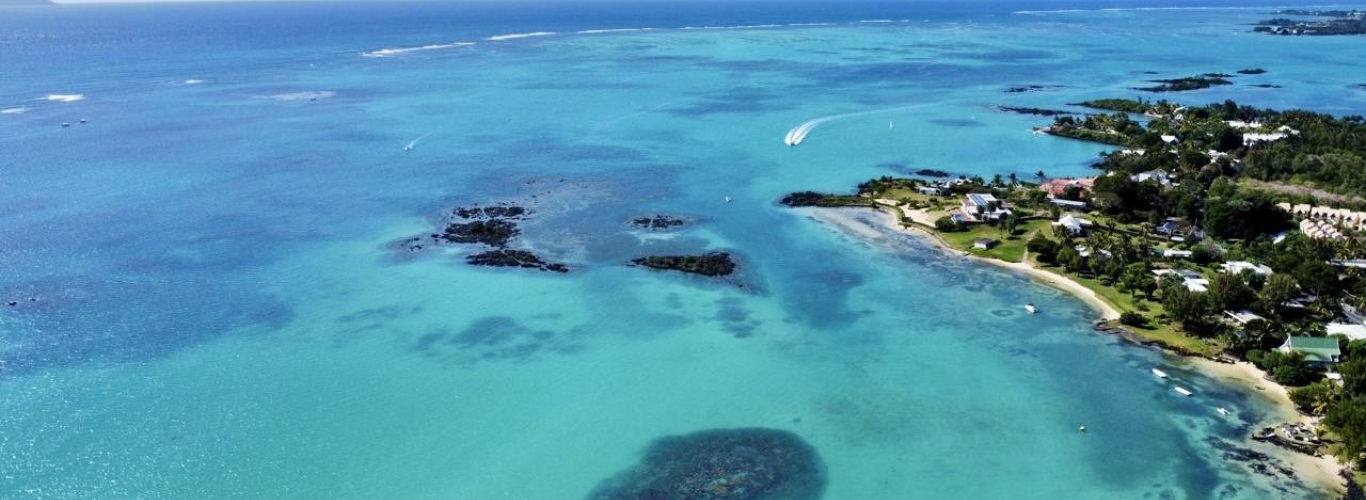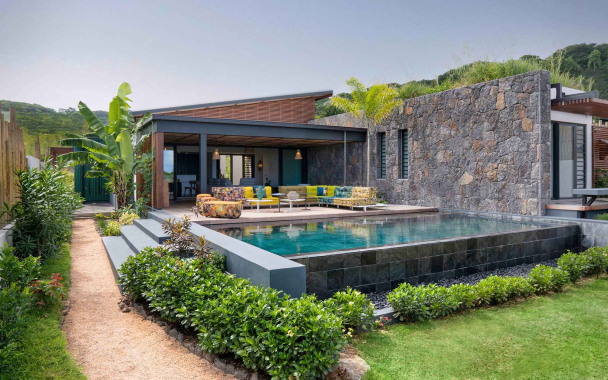Mauritius is full of stunning natural sites and small villages still untouched by mass tourism. These natural wonders and places rich in Creole culture reveal a wild and authentic side of the island where nature reigns.
But Mauritius is also a living memory: between the traces of slavery visible at Le Morne and the island’s colonial history, the cultural heritage is intertwined with breathtaking landscapes.
Discover the 10 natural and authentic wonders of Mauritius to make your stay a unique experience.

Let yourself be guided through our Top 10 natural and authentic wonders of Mauritius to experience unforgettable and must-see adventures!
Le Morne Brabant: between heritage, hiking, and lagoon
Overlooking the southwest coast of Mauritius and rising over 550 meters, Le Morne Brabant is much more than a mountain: it is a UNESCO World Heritage historical site. It holds the poignant memory of runaway slaves who sought refuge there in the 18th century and, fearing capture, jumped to their deaths. Today, a memorial pays tribute to this history.
Hikers, trail runners, and casual walkers can discover spectacular panoramas between turquoise seas and tropical nature. Its ascent, with a very challenging second half, reveals a breathtaking view. At its base, an idyllic beach stretches out, bathed in golden light at sunset. Morne Beach is also a renowned spot for kitesurfing and windsurfing.
Le Morne Brabant invites both relaxation and adventure, as well as reflection, within a magnificent natural setting. At sunset, with its shimmering lagoon, the silhouette of Le Morne offers an unforgettable spectacle.
Baie du Cap village: the authentic charm of southern Mauritius
If you’re looking for peace and a change of scenery, set your course for this village without hesitation! Baie du Cap, a small fishing village of around 2,000 inhabitants, is nothing short of a little paradise. Nestled between lush green mountains and a turquoise lagoon, it offers a picturesque setting perfect for nature and authenticity lovers.
The road leading there winds between basalt cliffs and sugarcane fields—a beautiful promise even before you arrive. Once there, a different rhythm takes over: the gentle Mauritian way of life. Traditional corrugated iron houses with colorful wooden shutters, children playing in the streets, fruit vendors at the corners… Here, strangers are greeted with smiles. The welcome is sincere, generous, and the atmosphere wonderfully peaceful. Take your time wandering through the narrow lanes or along the shoreline. Its clear, shallow waters invite you to swim or simply enjoy a moment of pure contemplation.
Photography enthusiasts will have plenty to fill their memory cards: emerald reflections on the lagoon, fishermen’s pirogues, fiery sunsets... but Baie du Cap’s charm also lies in its old Creole atmosphere. The retro-style post office, the quaint “old-fashioned” shops, the weathered walls worn by time… everything here seems suspended in time.
Baie du Cap is the real, authentic Mauritius, one that stays long in your memory. A village where every detail, every encounter, every landscape reflects the true face of Mauritius. Today, a restaurant offering a delicious take on Mauritian cuisine, Station A, will satisfy those looking for a well-deserved lunch or break. Down on the village esplanade, Anbalaboutik, a concept store, offers many objects and creations from local Mauritian producers and artisans.
And then, there’s Macondé. This rocky promontory, famous for its spectacular curve, offers an absolutely breathtaking view of the south coast. To be discovered in the next paragraph!
Macondé: a magical stop on one of the world’s most beautiful roads
Between Le Morne and Baie du Cap, the Maconde viewpoint offers one of the most spectacular panoramas of Mauritius
Ranked among the 10 most beautiful roads in the world, the B9 runs along the south coast of Mauritius and passes by Macondé, a rocky promontory steeped in history. Once a refuge for slaves fleeing the plantations, this site is now known for its breathtaking views of the lagoon and mountains.
Long difficult to access, the road is now passable year-round thanks to a new bridge. A short climb up a staircase leads to the top of the rock, where you can admire one of the island’s most stunning viewpoints. Visitors enjoy the sound of the waves, basalt cliffs, and sometimes the silhouettes of fishermen in the distance.
Macondé is a must-stop! For a peaceful visit, it’s best to come early or on weekdays.
Gris-Gris and La Roche qui pleure: dizzying cliffs and crashing waves
At the southernmost tip of Mauritius, Gris-Gris reveals a striking landscape, far from the calm lagoons. Here, steep cliffs plunge directly into the ocean, with no reefs to break the waves. This powerful, windy setting (often compared to Brittany) is dominated by La Roche qui Pleure (“the crying rock”), named because the streaming water looks like tears falling from the rock. The writer Paul-Jean Toulet described it as a place of dark and striking beauty.
Swimming is not recommended, but the walking trails and viewpoints are well worth the visit. It’s also the perfect spot for photography enthusiasts and picnics with breathtaking views.
Many poets and travelers, including Robert Edward Hart, have been inspired by the wild southern atmosphere.
Just nearby, Souillac and the Rochester Falls complete this excursion blending raw nature, culture, and poetry.
Cascade Rochester: a refreshing swim away from the lagoon
Rochester Falls takes its name from Charlotte Brontë’s 1847 novel Jane Eyre. The estate where it’s located was named after the novel’s main character, Edward Rochester. This naming dates back to the colonial period when British settlers gave literary names to various places on the island.
These waterfalls offer an impressive natural spectacle. The water plunges forcefully over cliffs sculpted for millennia into basalt columns with surprisingly rectangular shapes. Accessible on foot through sugarcane fields, the falls provide a wild and peaceful setting, far from the usual tourist routes.
Still well-preserved, Rochester Falls charms visitors with its intimate atmosphere, attracting walkers and photographers, locals and curious travelers alike.
It’s best to avoid visiting during the rainy season when currents are strong and trails slippery. But off-season, it’s a magical place to discover on foot, mountain bike, or quad through the sugarcane fields!
Souffleur
Here’s an off-the-beaten-path visit! Le Souffleur remains little known to both tourists and locals. It is a natural cavity carved by waves in the rock. When the sea is rough, with well-spaced waves and a moderate tide, water rushes in and creates a powerful jet of water, like a geyser. This blast is accompanied by a booming roar, which legend says can be heard for several kilometers. A fascinating natural show not to be missed.
To reach it, you must cross a sugar factory and then take a rough road for several kilometers. Epic!
Pont Naturel
Located between Le Souffleur and Le Bouchon, the Natural Bridge offers an impressive view of the raging ocean. This natural arch is perfect for unique photo shots. Here, the sea crashes violently against the cliffs, making swimming impossible.
But it’s exactly this intensity that makes the place spectacular. A wild site to discover for lovers of untamed landscapes.
7 Colors Earth
The dunes of Chamarel reveal layers of sand in shades of red, purple, blue, yellow, and green, bearing witness to 600 million years of geological history. The geopark, which covers about 8.5 hectares, raises awareness about geology while protecting this unique environment.
On-site, a café and a restaurant offer a pleasant break. The visit is ideally combined with a stop at Chamarel Falls, visible on the way. At 100 meters high, it is the tallest waterfall in Mauritius.
La Prairie Beach
Back near Le Morne, La Prairie is a preserved beach lined with casuarina trees and a lagoon with crystal-clear waters. Far from mass tourism, it mainly attracts locals for family picnics and its friendly atmosphere. Dominated by Le Morne mountain, it offers an ideal setting for swimming and snorkeling amid dazzling nature.
Visit during the week for more tranquility or on weekend late afternoons to enjoy the festive atmosphere. It is also one of the best spots in Mauritius to watch the sunset.
Le Crystal Rock
Off the coast of Le Morne, this spectacular coral formation rises majestically from the turquoise lagoon. A true natural gem, Crystal Rock offers a peaceful ambiance, ideal for snorkeling thanks to its clear waters and abundant marine life.
Boat excursions departing from La Gaulette, Tamarin, or Flic-en-Flac allow visitors to admire this large coral rock and sometimes spot dolphins.
Stay right next to all these natural wonders!
Do you know what all these Mauritian wonders have in common? They’re all located in the south of Mauritius. And what better way to explore them than by staying close to these exceptional sites?
Domaine d’Anbalaba, in Baie du Cap, is the perfect place. Nestled in the heart of an authentic fishing village, it offers a peaceful setting with spectacular views over the southern lagoon.
Discover our holiday villas and apartments available for rent—don’t wait any longer!

